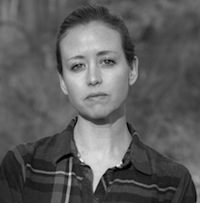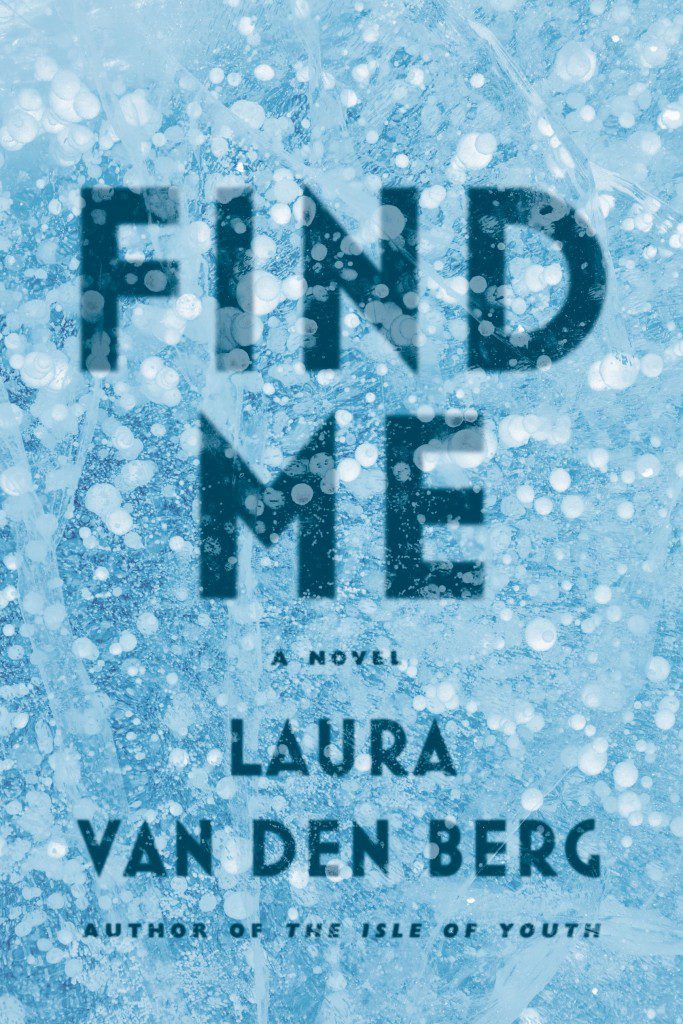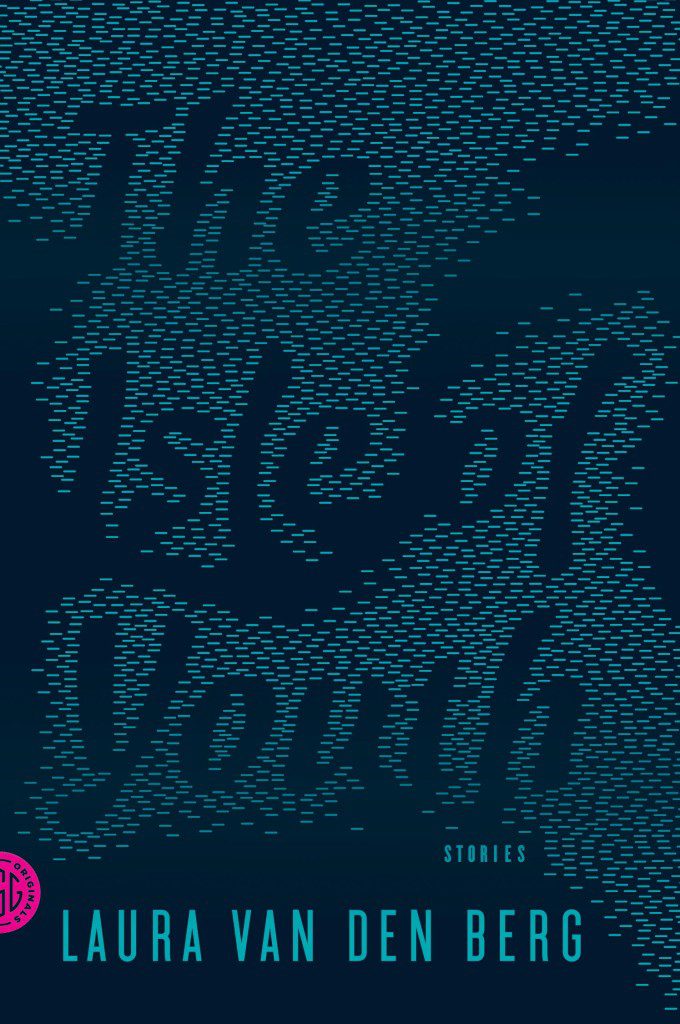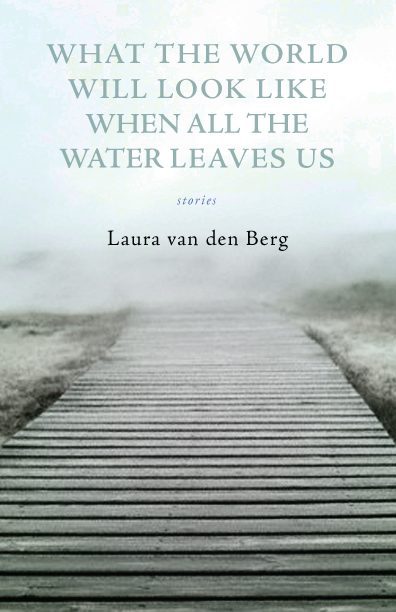
Things I will never forget about Find Me: the website on which you learn whether your loved ones are alive or dead is WeAreSorryForYourLoss.com; a plastic rabbit mask and the defeated, injured eye beneath it; the world’s most sinister cardboard toilet paper roll.
Find Me, Laura van den Berg’s first novel, follows Joy Jones, a cough syrup-addicted Stop & Shop cashier, in the face of a widespread epidemic, known only as “the sickness,” which leads to memory loss and death. A small number of people seem to be somehow immune to the sickness (including our protagonist Joy) and are routed to a hospital in isolated, frozen Kansas to have their genetic makeup studied by scientists who are hoping to find a cure. The first half of the novel takes place entirely inside the hospital. In the second half, Joy embarks on a journey to find her mother, who abandoned her as a baby, and to uncover the events of a year repressed entirely from her memory. Along the way, she recovers her humanity vis-à-vis her relationships with key players from her past and with mysterious strangers in the new, dystopian America.
Van den Berg’s descriptions of cognitive decline ring heart-wrenchingly true; I was reminded of Julianne Moore’s devastating portrayal of early-onset Alzheimer’s in Still Alice. Glimmers of other-worldliness percolate throughout the hospital scenes, adding dimension to what could be stifling: a metaphysical dirt tunnel built by charming twin boys, “pilgrims” pounding on the glass from the winter-bitten outside. Van den Berg skillfully withholds and disperses information at precisely the right moments; her novel presents a cutting, meticulous character study and an insightful exploration of motherhood, survival, and agency.
I spoke with Laura at a coffee shop in Prospect Heights. As we left, I said, “This book made me want to write something beautiful and crawl into a hole,” which, as an MFA student, may be the ultimate compliment.
***
The Rumpus: Where did the inspiration for this project come from? Was the process different working on a novel as opposed to working on short stories?
Laura van den Berg: It was different. Some people have asked me, did you feel pressured to write a novel? I think certainly that pressure is a real thing for people who’ve written primarily short stories. But it wasn’t really a thing for me specifically. The thing that I had very early on was the character of Joy, in a rough sense. Her character and her voice. So that was definitely my initial entryway into the world. I also had a sense of the architecture very early on. The idea of the first part being set in a confined space and the second part being set on the road. When I thought of that shape, I couldn’t conceive of it as a short story. A larger canvas was required. So in that way it did feel different, to have that architecture so early, which is not usually my experience writing stories, which tend to start for me with a voice.
In terms of the broader conceit of the book, when I started I had just finished my MFA and my husband and I had moved to rural North Carolina for about eight months and we were writing a ton. That’s when I wrote the first draft of the novel; this was in 2008. I think it probably says something about my personality that we were like, living in this little alleged utopia and I was like, “Hm, what seems like the most appealing thing now? A dystopia.”  But also—it was coming out of the Bush years, and it was a really dark time for our country, and everything just felt super fucked up. That certainly informed my decision to move in that direction. But really more than anything I was driven by Joy’s character. I think of the book as a very interior novel that’s tracking a very interior journey. Joy was always the center to me.
But also—it was coming out of the Bush years, and it was a really dark time for our country, and everything just felt super fucked up. That certainly informed my decision to move in that direction. But really more than anything I was driven by Joy’s character. I think of the book as a very interior novel that’s tracking a very interior journey. Joy was always the center to me.
Rumpus: What sort of challenges did you face having the first half of the novel in this entirely contained setting?
van den Berg: My natural comfort zone as a writer is to write about characters in motion, but both parts were challenging in different ways. I would say the challenge of the first part is how to make stasis feel active, because you have characters who are in this enclosed environment and have very limited information in terms of what’s happening in the outside world. So it was a challenge to give those sections forward momentum and not have them feel repetitive. Here we are in the common room again! But the great thing about writing the first part was there was a natural shape to it because I knew it would end with Joy leaving the hospital. And also, because of the constraints, certain options were immediately closed off.
While the second half felt more natural, it actually went through radically different versions because it was so open and anything could happen and it took me a really long time to figure out the right series of events, what could lead Joy to that final moment. Actually Everyday Genius published a list of all the things that I’d cut out of the novel, and if you look at the list, especially if you’ve read the book, it sounds crazy. It is crazy! At one point there were government conspiracies and a ghost ship. I mean.
It took me a really long time to excavate the core of Joy’s character, and for a while I was like, I’ll just have more stuff happen! I’ll just have more stuff happen! It took me a while to realize that I was actually obscuring Joy’s character as opposed to illuminating it.
Rumpus: That happened when you were at a residency in Key West?
van den Berg: Yeah. I worked on the book at a couple of different residencies, but I did this huge revision in Key West after I had sold the novel. I was really excited, but also the prospect of people actually reading it was becoming terrifyingly real. I knew the second part wasn’t right, but I had been working on it for so long. I’m sure you can probably relate to that fatigue. At the Key West residency, a little time pressure was good for me. I knew I couldn’t work on the book for two more years. My chances were dwindling. It really helped to say, fuck it, that’s not the right thing, I’m going to figure out what the right thing is.
Rumpus: Are you nostalgic for any of the things that you cut?
van den Berg: No! I don’t even remember. Unless I was doing the exercise of making a list of what I cut, I would never think about it. For a while, there was a subplot with a televangelist that sort of snaked through the first part and the second part. I couldn’t imagine cutting it, and then when I cut it, I couldn’t imagine it being in the book. It was the strangest thing. But I also knew that that meant it was the right decision.
Rumpus: That’s funny; on the way here I was thinking that it struck me that there was no religious element in this book. I thought, Am I misremembering it? Because it’s such a common aspect of dystopia.
van den Berg: Yeah, and I think one of the inherent problems with the televangelist is that in some ways Dr. Beck is a kind of televangelist. He has an ideology. His Book Two counterpart is Nelson in the Mansion, who in this alternate universe, Through-the-Looking-Glass-way also has an ideology and is televangelistic in that sense too. Effectively I already had two televangelist-like figures in the book and to have a third was too much.
Rumpus: One line that really jumped out at me was, “We are a nation of people with a deep desire to die.” That line had such teeth. Can you talk a little bit about how you conceptualize America and “American-ness” within this novel?
van den Berg: With a lot of the dystopian books, the phenomenon is often global, but it was actually really important to me to confine it to America, partly because I didn’t see it as the kind of book that needed that large a canvas, so limiting the sickness to America was a way to focus the world, but also I was less interested in the mechanisms of a global collapse than I was in Joy’s interior quest. Also, there were specifically American things that I wanted to try and look at in the book.
In our culture we’re so paranoid about safety and about certain kinds of propriety and “right-ness,” but we’re also phenomenally self-destructive. You see that playing out on a political plane, on a social plane, certainly on an environmental plane. We make collectively bad choices for ourselves all the time. That’s not a uniquely American problem, but it so happens that I am an American. I’ve lived in this country my whole life, and that’s the lens through which I’ve seen these problems play out and continue to play out.
The American landscape influenced the book too. Almost all of the landscape details are from life. In the six years that I wrote the book, I moved around a huge amount. I was in five or six different states, and spent a lot of time on the road. I think if you’re out in this country so much, you just see a lot of weird stuff. Weird, ominous stuff. [Laughs] You are exposed to the surreal pockets of Americana when you’re on the road a ton: the apocalyptic religious billboards, the empty diners, the bizarre roadside theme parks. Abandoned barns and strips malls and blocks and abandoned farmlands. Landscape had a huge hand in shaping the world.
Rumpus: How do you approach the balance between surrealism and more traditional realism within your work? Does one come more naturally than the other?
van den Berg: The intersection is what comes naturally to me. It’s very rare for straight realism to come naturally to me and while occasionally I might write a story that’s full-on magical, it’s rare for me to work fully in that direction.  And I love a lot of writers that are occupying both ends of the spectrum. I love Alice Munro. I love Kelly Link and Karen Russell and George Saunders and Murakami. I love Edward P. Jones and Charles Baxter. But that midpoint between the real and the surreal is where I most often find myself.
And I love a lot of writers that are occupying both ends of the spectrum. I love Alice Munro. I love Kelly Link and Karen Russell and George Saunders and Murakami. I love Edward P. Jones and Charles Baxter. But that midpoint between the real and the surreal is where I most often find myself.
In some ways, I find that middle to be truer to how we experience the world, or at least how I experience the world. You know, in real life, we’re so bound by social contract that we all sign at a certain point. Except there are a few people who don’t sign it, and those people are sometimes sort of terrifying or sometimes sort of amazing. [Laughs] But in fiction, our characters aren’t bound to those social contracts. They don’t have to sign them. And to me, that’s one of the great joys of writing fiction. To let the inexplicable and the inexpressible and the mysterious bubble up to the surface a little bit more than tends to be possible in life.
Rumpus: What was your process of research like for this book?
van den Berg: I read two books on epidemics, Killer Germs and Flu. Those were helpful with some of the practical details and for amassing a bank of terrifying disease facts. Later in the process Andrea Elliott’s “Invisible Child” series for the New York Times and Matt Taibbi’s “Apocalypse New Jersey: Dispatches From America’s Most Desperate Town” for Rolling Stone. They illuminate the American dystopia that is already, and has long been, among us.
Rumpus: We’ve talked a bit about Station Eleven, but it feels like there’s such resurgence of dystopia—not just in literary fiction, but in TV, film, The Hunger Games. I’m wondering, what do you think is drawing us towards that in this present cultural moment?
van den Berg: I think in some ways it’s an acknowledgment of that self-destructive impulse I mentioned earlier. For example, knowing that we’re galloping towards a catastrophic environmental crisis, knowing that we’re already in the midst of an environmental crisis, and yet there is this sense that maybe you can’t turn the Titanic away from the iceberg. I certainly recycle and do the common sense things that one can, but there is part of me that thinks deep down: how much good is this really doing? Just because the problems that we face are so overwhelmingly complicated and vast. Can we as a country really change in the ways we need to? And so I wonder if there is a kind of acknowledgment that we’re dooming ourselves. Part of that acknowledgment is wanting to see all of the imaginary ways the end might play out, how the consequences of our collective choices might play out. What our imagined future might look like.
Maybe it will be the zombie apocalypse. I did have this moment when this news story broke about bath salts in Florida, and people having these cannibalistic impulses. I was like, see, I knew it was going to start in Florida. [Laughs]
But absolutely it’s a reflection of this fear that we feel as a culture about the unsustainability of our way of life, and our world. But that said, while there has been a big new wave of dystopian fiction, dystopian literature has a very long, rich history. And I think, you know, from generation to generation there are times when the world feels crazy, and the struggles unlivable, and the consistency of that feeling from one generation to the next accounts for why dystopian literature has had such a long tradition.
Rumpus: Is it significant that the sickness originates in California?
van den Berg: In some ways I think of California and Florida being very similar. I’ve visited California a number of times, but I’ve not spent significant amounts of time there so Californians might be offended that I’d make that connection. But they’re both big states, and they’re states that contain different cultures within. So to be from South Florida is very different than to be from Central Florida, different from North Florida, from the Panhandle, from the Keys… it’s like you have all these different little countries, really starkly different cultures, contained within one state. My impression of California is that it’s very different to be from the desert vs. LA vs. Northern California, and so on. They’re states that both have weird extreme weather; states that seem unstable in some basic way. Florida is sinking; California has fires and earthquakes. I really love LA, but when I’m there everything in LA vaguely looks like a crime scene to me (I mean that in the best way) and there are parts of Florida that have a similar aesthetic. I didn’t want the sickness to begin in Florida because I didn’t want the place that Joy was traveling toward to be Ground Zero. But California seemed like a Florida-cousin and thus a logical point of origin.
Rumpus: Were there specific works that you drew inspiration from?
van den Berg: Definitely. Fiona Maazel’s novel Last Last Chance, which I love. That was also the first dystopic novel I read where, on the one hand, this killer plague is happening and, on the other, the world is still operating. People are still eating regular food and going to rehab and taking walks. I knew that that was the sort of plague I wanted to have happen; I wanted the world to be altered but I wanted it to be more like a surreal now than a scorched earth End Times that you might find in The Road, for instance. I’m a huge fan of Grace Krilanovich’s novel The Orange Eats Creeps—the way that book moves was really inspirational for me. Victor La Valle’s novel Big Machine was a big influence, and so many others. Books where the world was very altered, but it wasn’t post-apocalyptic in the more familiar sense. Reading those books, it gave me a great sense of freedom, like, I can have that happen, but I don’t necessarily have to follow the usual tropes.
Rumpus: I think you’re the first person I’ve read who addressed cough syrup as an addictive substance. Did you know at first that Joy was going to be self-medicating using that particular drug? Did that unfold organically?
van den Berg: It unfolded organically. I can’t say—I mean, I definitely used cough syrup as a teenager. [Laughs] Practically everyone I knew in Florida did, anyway, at a certain age. It seemed very natural as I was building the world of the Stop & Shop that Joy would be in a slightly altered state herself. Given the depth of Joy’s problems, for a moment I paused and said, maybe she should be using something more “serious,” like she should be on heroin or Oxycontin. But I think there were some practical problems with that; I didn’t want the book to become an addiction and recovery narrative, for one thing. It didn’t feel quite right for the world. So I think it made sense for her to self-medicate using something cheap and easy and steal-able. Something that’s right there in the Stop & Shop.
Rumpus: What were your other intuitive character choices?
 van den Berg: I think to have her work in the Stop & Shop. There were tons of different jobs she could do, but the loneliness and the isolation and the weirdness of working the graveyard shift at a 24-hour grocery… I actually had a friend who did that, not at Stop & Shop, but at a different grocery store, when he was living in Minneapolis. And it was the most normal place during the day—this perfectly normal, nice grocery—and then at night, all these weird people would be roaming around, buying the strangest stuff. This Twilight Zone grocery. When thinking of a job for Joy, I thought, “That’s exactly where she’d be: at the Twilight Zone grocery.”
van den Berg: I think to have her work in the Stop & Shop. There were tons of different jobs she could do, but the loneliness and the isolation and the weirdness of working the graveyard shift at a 24-hour grocery… I actually had a friend who did that, not at Stop & Shop, but at a different grocery store, when he was living in Minneapolis. And it was the most normal place during the day—this perfectly normal, nice grocery—and then at night, all these weird people would be roaming around, buying the strangest stuff. This Twilight Zone grocery. When thinking of a job for Joy, I thought, “That’s exactly where she’d be: at the Twilight Zone grocery.”
Rumpus: Are any of the morbid games that Joy and Marcus play (“The Grand Obituary,” etc.) based on your own childhood? Were you interested in that sort of thing?
van den Berg: Nobody’s ever asked me that before. No, I can’t say that that’s a detail that comes from life, in my recollection. I grew up with lots of pets, so most of my games revolved around animals. I was always trying to dress up my dogs and to teach them to do tricks, not very successfully. We’d have societies that all the pets played integral roles in, and so forth. So my games did not necessarily have that super morbid slant to them.
It’s a good question, though, because in Find Me, lists and games are a really important part of the landscape. It’s something that we see in the hospital, where the twins play that they’re zombies, and certainly there are a lot of games in the Mansion. I think both are an attempt to deal with the reality at hand. The lists are an attempt for Joy to order her world, and the games work in a similar way. We get a sense of order through the rules, through the firm boundaries. In some ways, reality is so incomprehensible that it makes sense to slip into a different corner of reality.
Rumpus: Do you have any advice about crafting a perfect ambiguous ending?
van den Berg: Oh! [Laughs]
Rumpus: [Laughs] That was such a face.
van den Berg: Let’s see. Well—I think that any time one chooses ambiguity, there needs to be reasoning behind it. In writing Find Me, there were different incarnations of the ending that were equally ambiguous, but it was ambiguous because it was like… oh I don’t really know, I think I’m going to stop here! [Laughs] I didn’t really understand how my own intent was working, and thus those endings felt like someone just stopped at a random point, as opposed to an arc having been completed. But with both stories and novels, when I think of plot and structure, I think a lot in terms of character arc as opposed to resolving questions of plot.
When I think of Joy—where she started, and where I wanted her to end up, in my mind I wanted her to end reaching a moment of inner calm and inner fortitude, while at the same time there’s this vast sea of the unknown that’s lying at her feet. But the last moments, and certainly the last line, are all declaratives. Finally she’s the one giving orders—no one’s talking to her at the hospital, it’s not Nelson in the Mansion, not anyone from her past. The directives are coming from her. And there’s a sense of fury and strength that’s been missing from Joy previously. When I reached that moment, it seemed like a logical place to end for me. I knew that her arc had been completed.




